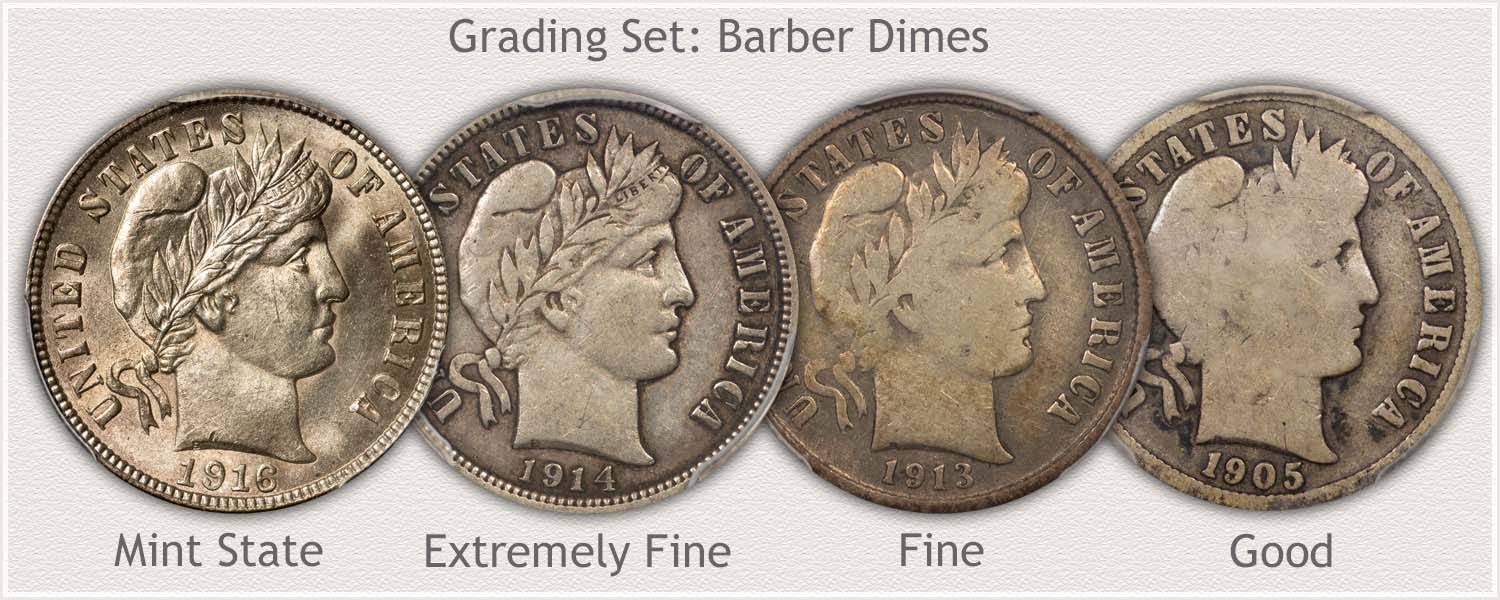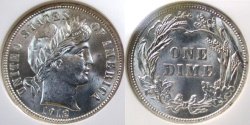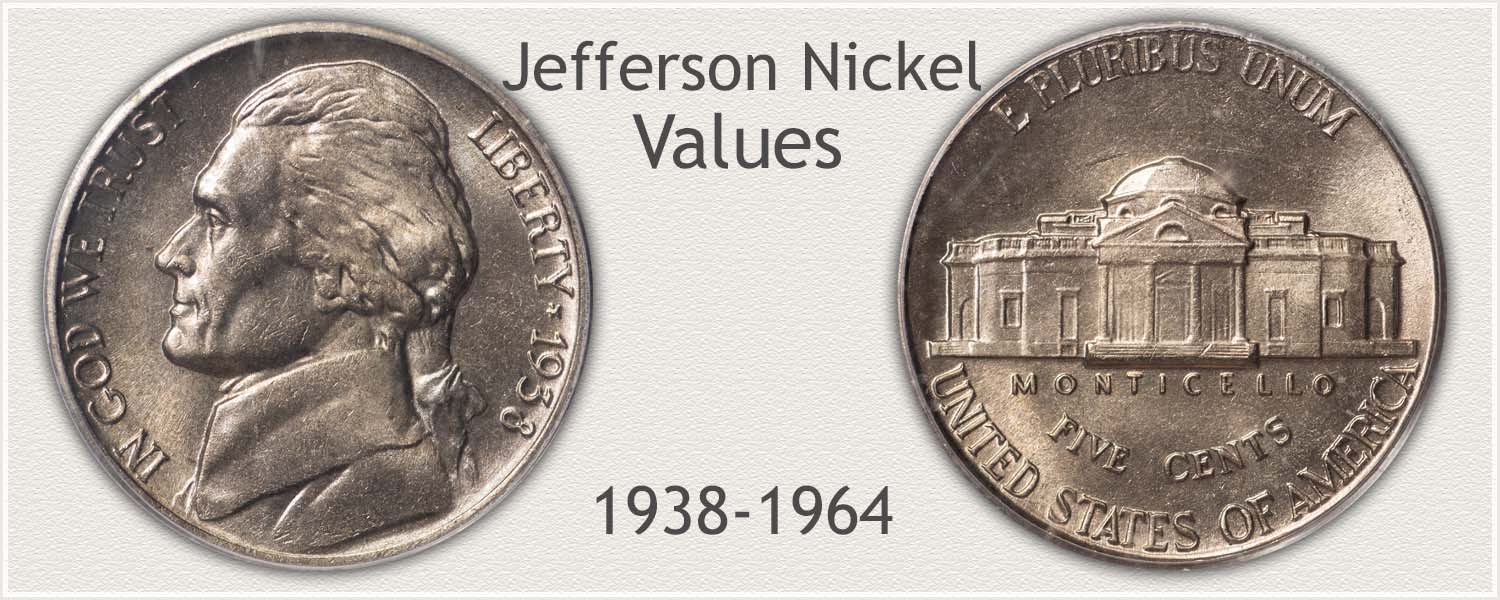Barber Dime
The Barber Dime was minted between the years 1892 to 1916, inclusive. Throughout the series, the coins were struck at the Philadelphia, New Orleans, San Francisco, and Denver Mints. In general, the mintages were the highest at Philadelphia and more limited at the branch mint locations.
The Barber dime was minted from 1892 through 1916. Like Barber’s other silver designs, the dime was a workhorse, widely used in everyday commerce. For the most part, the mintages were relatively high, with eight-digit mintages occurring for many of the Philadelphia products. Barber Dimes minted from 1892 to 1916 are considered classic American coins and some of them can be quite valuable. The United States Mint used the Barber design on three different denominations including the dime, quarter and half dollar. Barber Dimes US Barber Dimes are a great coin to collect. A very challenging series, the Barber Dimes were minted from 1892-1916 from various mints throughout the country.


The Barber dime is a classic American coin with values on the low end tied to the silver bullion market. On the upper end of the spectrum are pieces like the 1894-S Barber dime, which sells at auction for more than $1.5 million. The Barber Dime also known as the Liberty Head dime was minted from 1892 and 1916 by Charles Barber. These are more commonly called 'Barber Dimes' because of this. The coins were originally meant to be designed by the public but later taken over by Charles Barber the current Chief Engraver for the United States Mint due to financial issues.
The lowest mintage for a circulation strike of the series was the 1895-O at 440,000 pieces. The highest production occurred with the 1907 Barber Dime at more than 20 million coins.
Numerous issues have mintages below the one million mark. Generally, these coins command premium prices compared to the higher mintage issues.
Barber Dimes 1892 1916
Below is a table of the mintages for Barber Dimes stuck for circulation.
1894 Barber Dime

Liberty Head Dime Value Chart

Barber Dime Key Dates
| 1892 | 12,120,000 |
| 1892-O | 3,841,700 |
| 1892-S | 990,710 |
| 1893 | 3,340,000 |
| 1893-O | 1,760,000 |
| 1893-S | 2,491,401 |
| 1894 | 1,330,000 |
| 1894-O | 720,000 |
| 1895 | 690,000 |
| 1895-O | 440,000 |
| 1895-S | 1,120,000 |
| 1896 | 2,000,000 |
| 1896-O | 610,000 |
| 1896-S | 575,056 |
| 1897 | 10,868,533 |
| 1897-O | 666,000 |
| 1897-S | 1,342,844 |
| 1898 | 16,320,000 |
| 1898-O | 2,130,000 |
| 1898-S | 1,702,507 |
| 1899 | 19,850,000 |
| 1899-O | 2,650,000 |
| 1899-S | 1,867,493 |
| 1900 | 17,600,000 |
| 1900-O | 2,010,000 |
| 1900-S | 5,168,270 |
| 1901 | 18,859,665 |
| 1901-O | 5,620,000 |
| 1901-S | 593,022 |
| 1902 | 21,380,000 |
| 1902-O | 4,500,000 |
| 1902-S | 2,070,000 |
| 1903 | 19,500,000 |
| 1903-O | 8,180,000 |
| 1903-S | 613,300 |
| 1904 | 14,600,357 |
| 1904-S | 800,000 |
| 1905 | 14,551,623 |
| 1905-O | 3,400,000 |
| 1905-S | 6,855,199 |
| 1906 | 19,957,731 |
| 1906-D | 4,060,000 |
| 1906-O | 2,610,000 |
| 1906-S | 3,136,640 |
| 1907 | 22,220,000 |
| 1907-D | 4,080,000 |
| 1907-O | 5,058,000 |
| 1907-S | 3,178,470 |
| 1908 | 10,600,000 |
| 1908-D | 7,490,000 |
| 1908-O | 1,789,000 |
| 1908-S | 3,220,000 |
| 1909 | 10,240,000 |
| 1909-D | 954,000 |
| 1909-O | 2,287,000 |
| 1909-S | 1,000,000 |
| 1910 | 11,520,000 |
| 1910-D | 3,490,000 |
| 1910-S | 1,240,000 |
| 1911 | 18,870,000 |
| 1911-D | 11,209,000 |
| 1911-S | 3,520,000 |
| 1912 | 19,349,300 |
| 1912-D | 11,760,000 |
| 1912-S | 3,420,000 |
| 1913 | 19,760,000 |
| 1913-S | 510,000 |
| 1914 | 17,360,230 |
| 1914-D | 11,908,000 |
| 1914-S | 2,100,000 |
| 1915 | 5,620,000 |
| 1915-S | 960,000 |
| 1916 | 18,490,000 |
| 1916-S | 5,820,000 |